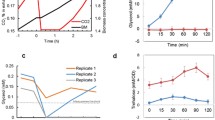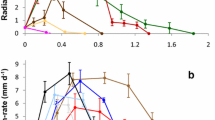Abstract
As glycerol was suggested as an osmotic agent in the salt tolerantDebaryomyces hansenii the concentrations of total, intracellular, and extracellular glycerol produced by this yeast was followed during growth in 4 mM, 0.68 M, and 2.7 M NaCl media. The total amount of glycerol was not directly proportional to biomass production but to the cultural salinity with maximum concentrations just prior to or at the beginning of the stationary phase. In all cultures the cells lost some glycerol to the media, at 2.7 M NaCl the extracellular glycerol even amounted maximally to 80% of the total. A distinct maximum of intracellular glycerol, related to dry weight or cell number, appeared during the log phase at all NaCl concentrations. As the intracellular calculated glycerol concentrations amounted to 0.2 M, 0.8 M, and 2.6 M in late log phase cells at 4 mM, 0.68 M, and 2.7 M NaCl, respectively, whereas the corresponding analysed values for the glycerol concentrations of the media were 0.7 mM, 2.5 mM, and 3.0 mM, glycerol contributes to the osmotic balance of the cells.
During the course of growth all cultures showed a decreasing heat production related to cell substance produced, most pronounced at 2.7 M NaCl. At 2.7 M NaCl the total heat production amounted to-1690 kJ per mole glucose consumed in contrast to-1200 and-1130 kJ at 4 mM and 0.68 M NaCl, respectively. TheY m -values were of an inverse order, being 129, 120, and 93 at 4 mM, 0.68 M, and 2.7 M NaCl, respectively.
Similar content being viewed by others
References
Borowitzka, L. J., Brown, A. D.: The salt relations of marine and halophilic species of the unicellular green alga,Dunaliella. Arch. Microbiol.96, 37–52 (1974)
Brock, T. D.: Salinity and the ecology ofDunaliella from Great Salt Lake. J. gen. Microbiol.89, 285–292 (1975)
Brown, A. D.: Microbial water relations: features of the intracellular composition of sugar-tolerant yeasts. J. Bact.118, 769–777 (1974)
Brown, A. D.: Microbial water relations. Effects of solute concentration on the respiratory activity of sugar-tolerant and nontolerant yeasts. J. gen. Microbiol.86, 241–249 (1975)
Brown, A. D., Simpson, J. R.: Water relations of sugar-tolerant yeasts: the role of intracellular polyols. J. gen. Microbiol.72, 589–591 (1972)
Conway, E. J., Downey, M.: An outer metabolic region of the yeast cell. Biochem. J.47, 347–355 (1950)
Eriksson, R., Holme, T.: The use of microcalorimetry as an analytical tool for microbial processes. Biotechnol. Bioeng. Symp.4, 581–590 (1973)
Forrest, W. W.: Entropy of microbial growth. Nature (Lond.)225, 1165–1166 (1970)
Forrest, W. W.: Microcalorimetry. In: Methods in microbiology, Vol. 6 B (J. R. Norris, D. W. Ribbons, eds), pp. 285–318. New York: Academic Press 1972
Gezelius, K., Norkrans, B.: Ultrastructure ofDebaryomyces hansenii. Arch. Mikrobiol.70, 14–25 (1970)
Gould, G. W., Dring, G. J.: Heat resistance of bacterial endospores and concept of an expanded osmoregulatory cortex. Nature (Lond.)258, 402–404 (1975)
Hall, J. L., Yeo, A. R., Flowers, T. J.: Uptake and localization of rubidium in the halophyteSuaeda maritima. Z. Pflanzenphysiol.71, 200–206 (1974)
Kemp, R. B., Ross, P. D.: Report on “Second International Symposium on Microcalorimetry in Microbiology”, Bedford College, London, 25–26 March, 1975, Microcalorimetry Research Report5 (1975)
Monk, P., Wadsö, I.: A flow micro reaction calorimeter. Acta chem. scand.22, 1842–1852 (1968)
Moore, P. D.: Proline implicated in halophyte osmotic adjustment. Nature (Lond.)253, 399–400 (1975)
Norkrans, B.: Studies on marine occurring yeasts: growth related to pH, NaCl concentration and temperature. Arch. Mikrobiol.54, 374–392 (1966)
Norkrans, B.: Studies on marine occurring yeasts: respiration, fermentation and salt tolerance. Arch. Mikrobiol.62, 358–372 (1968)
Norkrans, B., Kylin, A.: Regulation of the potassium to sodium ratio and of the osmotic potential in relation to salt tolerance in yeasts. J. Bact.100, 836–845 (1969)
Oiishi, H.: Osmophilic yeasts. Advanc. Food Res.12, 53–94 (1963)
Schaarschmidt, B., Zotin, A. I., Brettel, R., Lamprecht, I.: Experimental investigation of the bound dissipation function. Change of the ψu-function during the growth of yeast. Arch. Microbiol.105, 13–16 (1975)
Spencer, J. F. T.: Production of polyhydric alcohols by yeasts. In: Progress in industrial microbiology, Vol. 7 (D. J. D. Hockenhull, ed.), pp. 2–42. London: Iliffe 1968
Watson, T. G.: Effects of sodium chloride on steady-state growth and metabolism ofSaccharomyces cerevisiae. J. gen. Microbiol.64, 91–99 (1970)
Wickerham, L. J.: Taxonomy of yeasts. U.S. Dept. Agr. Techn. Bull. No. 1029, pp. 1–55 (1951)
Author information
Authors and Affiliations
Rights and permissions
About this article
Cite this article
Gustafsson, L., Norkrans, B. On the mechanism of salt tolerance. Arch. Microbiol. 110, 177–183 (1976). https://doi.org/10.1007/BF00690226
Received:
Issue Date:
DOI: https://doi.org/10.1007/BF00690226




